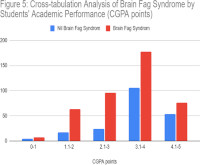The Brain Fag Syndrome and Its Associations: A Study Among Students of Bayero University Kano
DOI:
https://doi.org/10.60787/tnhj.v24i2.813Keywords:
Brain Fag Syndrome, Prevalence, Anxiety, Somatic Symptoms, School Burnout, Academic PerformanceAbstract
Background: Brain Fag Syndrome (BFS), first identified among students in Western Nigeria, has sparked debate regarding its classification and links to anxiety and depression. This study, conducted at Bayero University Kano, explores the prevalence and associations of BFS among third-year undergraduates using a descriptive cross-sectional approach.
Method: The study involved 700 third-year undergraduate students at Bayero University Kano, selected through multistage sampling. Data was collected quantitatively via a structured questionnaire covering socio-demographics, validated scales, and an open-ended section on stimulant use. An introductory cover letter assured participants of anonymity. Data analysis, conducted using IBM SPSS Statistics, incorporated descriptive and inferential statistical tests to reveal associations and patterns.
Result: The study found a 67.2% prevalence of BFS among Bayero University students, highlighting its significance as a psychological concern in this academic environment. Contrary to conventional expectations, a negative association between BFS and study-related anxiety was observed, suggesting a more complex relationship. No significant link was found between the syndrome and stimulant use. However, BFS was positively associated with somatic symptoms and school burnout. The prevalence of BFS was also influenced by faculty-specific and course-specific factors.
Conclusion: Brain Fag Syndrome extends beyond academic difficulties, involving anxiety, somatic symptoms, and burnout. Tailored interventions are essential to support affected students. The unexpected negative link to test anxiety requires further exploration. Recognizing the cognitive, emotional, and somatic dimensions of BFS is crucial for providing holistic support to students, given the syndrome's impact on academic performance.
Downloads
References
Prince RH (1962). Functional symptoms associated with study in Nigerian students. West Afr. Med. Journal, 11, 198-206.
Ola BA, Morakinyo O, Adewuya AO (2009). Brain fag syndrome: a myth or reality. Afr J. Psychiatry, 12, 135-143.
Peltzer K, Cherian VI, Cherian L (1998). Brain fag symptoms in rural South African Secondary School pupils. Psychol Ref, 83(3 pt 2), 1187-1196.
Anumonye A. (1978). Lorazepam in the treatment of 'brain fag syndrome. Afr J Psychiatry, 3, 121-123.
Guinness E (1992). Social origins of the brain fag syndrome. British Journal of
Psychiatry, 160(S16), 53-64.
Ayorinde OA (2008). Editorial: Brain fag syndrome: New wine in old bottles or old wine in new bottles? Nigerian Journal of Psychiatry, 6(2), 47-50.
World Health Organization. International Statistical Classification of Diseases and Related Health Problems, Tenth Revision (ICD-10). Geneva: World Health Organization; 1992.
Ola BA, Igbokwe DO (2011). Factorial validation and reliability analysis of the brain fag syndrome scale. African Health Sciences, 11(3), 334-340.
Ayorinde OA (2020). 'Brain fag': a syndrome associated with 'over study' and mental exhaustion in 19th-century Britain. International Review of Psychiatry, 32(5-7), 520-535.
Fatoye FO, Morakinyo O. Study difficulty and the "Brain Fag" syndrome in southwestern Nigeria. J Psychol Afr. 2003;13(1):70-80.
Morakinyo O (1980). Psychophysiological theory of a psychiatric illness (the Brain fag syndrome) associated with study among Africans. Journal of Nervous and Mental Disease, 168(2), 84-89.
Adayonfo, E. O., & Akhigbe, K. O. (2015). Stimulant: A correlate of Brain Fag Syndrome among undergraduate students in a Nigerian University? Nigerian Journal of Clinical Practice, 18(1), 90-94.
American College Health Association. (2018). American College Health Association-National College Health Assessment II: Reference group executive summary spring 2018. American College Health Association.
England, B. J., Brigati, J. R., Schussler, E. E., Chen, M. I., & Eddy, S. L. (2019). Student Anxiety and perception of difficulty impact performance and persistence in introductory Biology courses. CBE-Life Sciences Education, 18(2).
Demerouti, E., Bakker, A. B., & Leiter, M. (2021). Burnout and job performance: The moderating role of selection, optimization, and compensation strategies. Journal of Organizational Behavior, 42(7), 741-755. https://doi.org/10.1002/job.2531
Kaggwa, M. M., Namatovu, H. P., & Makumbi, F. E. (2021). Burnout among university students in low and middle income countries: A systematic review. BMC Psychology, 9(1), 179. https://doi.org/10.1186/s40359-021-00672-w
Ayinde, O. A., Azeez, A. A., Ologun, Y. O., & Abdulmalik, J. O. (2022). Prevalence of burnout and its correlates among Nigerian medical students. African Journal of Psychiatry, 25(4), 245-250. https://doi.org/10.1192/2055024221
Obekpa, C. T., Ndom, R. J. E., & Idu, F. K. (2020). Burnout and associated factors among university undergraduates in Northern Nigeria. Journal of College Student Psychotherapy, 34(2), 85-97. https://doi.org/10.1080/87568225.2019.1671992
Golonka, K., Gawlowska, M., Mojsa-Kaja, J., & Marek, T. (2019). Psychophysiological Characteristics of Burnout Syndrome: Resting-State EEG Analysis. Biomed Research International, 2019, 3764354. https://doi.org/10.1155/2019/3764354
Schlarb, A. A., Claßen, M., Hellmann, S. M., Vögele, C., & Gulewitsch, M. D. (2017). Sleep and somatic complaints in university students. Journal of Pain Research, 10, 1189-1199. https://doi.org/10.2147/JPR.S125421
Essien EA, Edet BE, Abdullahi H, Udofia O. Brain fag and burnout: A comparison of two exhaustion syndromes among adolescents in Nigeria. Open J Psychiatry Allied Sci. July 2023. Available at: https://www.researchgate.net/publication/372166568. Accessed 19th January 2024
March-Amengual JM, Cambra Badii I, Casas-Baroy JC, Altarriba C, Comella Company A, Pujol-Farriols R, Baños JE, Galbany-Estragués P, Comella Cayuela A. Psychological Distress, Burnout, and Academic Performance in First Year College Students. Int J Environ Res Public Health. 2022 Mar;19(6):3356. doi: 10.3390/ijerph19063356. PMID: 35329044; PMCID: PMC8953100.
Ayorinde OA, Obuaya C, Adeyemi SO (2015). Brain Fag Syndrome: a culture-bound syndrome that may be approaching extinction. BJPsych Bulletin, 39(4), 156-161.
History of BUK (2020). Buk.ed.ng. Bayero University Kano. Archived from the original on 1 December 2021. Retrieved 2021-12-01.
Yunusa F, Obembe A, Madakwi A, Asogwa F. A Survey of Psychostimulant Use among University Students in Northwestern Nigeria. Nigerian Journal of Psychiatry. 2011;9(3).
IBM Corp. Released 2010. IBM SPSS Statistics for Windows, Version 19.0. Armonk, NY: IBM Corp.

Published
Issue
Section
License
Copyright (c) 2024 Journal and Publisher

This work is licensed under a Creative Commons Attribution-NonCommercial-ShareAlike 4.0 International License.
The Journal is owned, published and copyrighted by the Nigerian Medical Association, River state Branch. The copyright of papers published are vested in the journal and the publisher. In line with our open access policy and the Creative Commons Attribution License policy authors are allowed to share their work with an acknowledgement of the work's authorship and initial publication in this journal.
This is an open access journal which means that all content is freely available without charge to the user or his/her institution. Users are allowed to read, download, copy, distribute, print, search, or link to the full texts of the articles in this journal without asking prior permission from the publisher or the author.
The use of general descriptive names, trade names, trademarks, and so forth in this publication, even if not specifically identified, does not imply that these names are not protected by the relevant laws and regulations. While the advice and information in this journal are believed to be true and accurate on the date of its going to press, neither the authors, the editors, nor the publisher can accept any legal responsibility for any errors or omissions that may be made. The publisher makes no warranty, express or implied, with respect to the material contained herein.
TNHJ also supports open access archiving of articles published in the journal after three months of publication. Authors are permitted and encouraged to post their work online (e.g, in institutional repositories or on their website) within the stated period, as it can lead to productive exchanges, as well as earlier and greater citation of published work (See The Effect of Open Access). All requests for permission for open access archiving outside this period should be sent to the editor via email to editor@tnhjph.com.





